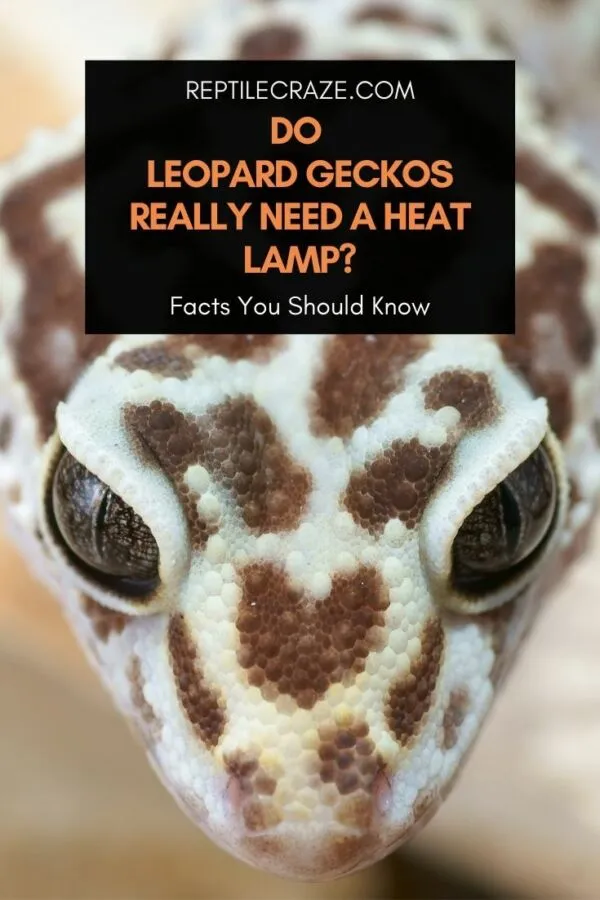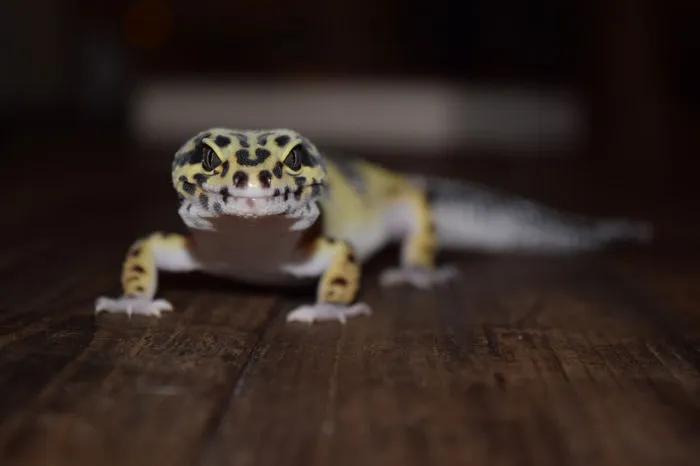
I’ve rescued and fostered several leopard geckos when they have become ill. This often happens because owners believe a heat lamp isn’t needed. While a heat mat is also a great option, omitting a heat lamp can significantly impede the health of your leopard gecko.
Leopard gecko tanks need a heat and light source to simulate the temperature and light differences between night and day. The best option for this is a heat lamp and a heat mat combo. Without both, leopard geckos can get too cold and are eventually unable to maintain the correct body temperature.
Needless to say, making sure you have the correct leopard gecko heat lamp and mat setup is crucial. But don’t worry, I’m going to help you understand everything you need to know about heat lamps and set them up so that your little leopard gecko buddy will be happy and live a long life.
Table of Contents
Why Leopard Geckos Need a Heat Lamp
Leopard geckos are lizards. These animals aren’t like you and me, and it’s not just the scaley skin! Lizards have colder blood than us mammals, also known as being ectothermic. While we are able to both tolerate colder climates and generate heat from our bodies, lizards can’t do this to the same degree. They need to absorb the extra heat from somewhere else.
While a heat mat can provide this heat on its own, an additional heat lamp helps to create a hot zone within your leopard gecko’s environment. This will help your gecko thrive. It simulates their real environment where some areas are warmer than others.
Also, and this might be the most important point, the light the heat lamp produces simulates the night and day cycle leopard geckos experience in the wild, providing the essential temperature and light differences to keep your leopard gecko healthy.
Why do Leopard Geckos Need Heat?
In the wild, leopard geckos absorb their heat from two places:
- The sun: That big shiny thing that burns me unless I wear Factor 50.
- Ambient temperature: A combination of air temperature and the heat from the ground, which has been created by our good old friend, the Sun.
Leopard geckos have evolved to use this heat for essential bodily functions. These include:
- Digesting
food - Breathing
- Excreting waste
- Helping to fuel cellular activity
- Regulating daily habits
- Providing energy for movement and reproduction
Even us warm-blooded creatures (known as endotherms) need sunlight and warmth to survive; your leopard gecko just needs more of it.

Heat Lamps and Temperature Gradients
A quick word here about creating temperature gradients in your leopard gecko
A temperature gradient simply means the difference between the hottest part of the
The coolest part of your
While leopard geckos don’t like sunshine very much and tend not to bask directly under a heat lamp, it’s important that they have the option. Just by having this hot light, you are making the shade even more appealing to your leopard gecko and encouraging your pet to use its environment as it would in the wild.
Occasionally, your leopard gecko will sit for a short time under the light, despite its aversion to it. Sometimes this is because they aren’t feeling well and need to raise their body temperature to increase their metabolism. It will then go to the shadier parts of your
Without a proper heat lamp, you can’t have this correct temperature gradient.
The entire
What About a Heat Mat On its Own Without a Heat Lamp?
In my opinion, a heat mat can be just as vital as a heat lamp, but it’s a mistake to think that you can do without a heat lamp if you have a mat. These mats slide under a
Some leopard gecko owners prefer a heat mat because they save space inside of the
If you are not going to use a heat mat, then remember that you must maintain 68 °F (20°C) at night in the leopard gecko
How Long Can a Leopard Gecko Live Without a Heat Lamp?
We’ve covered how long a leopard gecko can live without heat in great detail, but to recap: A leopard gecko can die within a couple of days if its temperature drops below 15.5°C (60F).
Even if the temperature is above this, a leopard gecko will live no longer than a month without a heat lamp and/or mat to simulate the temperature differences between night and day. This can happen sooner if there are other contributing stressors such as:
- Poor diet
- Underlying illness
- Competiting with another gecko for
food and territory - No other heat source
- Age
Do I Need a Heat Lamp if I live in a Warm Climate?
Even if you live in a warm climate, you’ll still need a heat source. If your
A room can also be prone to changes in air pressure. This creates drafts of air, some of which will be colder than the usual ambient temperature. Reptiles are notoriously susceptible to becoming ill even when the temperature drops only for a short while.
What’s most important is that you monitor the temperature of your
A heat lamp is still a great idea in warmer climates, as long as you keep an eye on the temperature. A heat mat is also a good idea as this will allow you to ensure a minimum safe temperature at night.

What Happens to a Leopard Gecko Without a Heat Lamp?
If your leopard gecko isn’t exposed to the correct temperatures via a night and day cycle, they’ll soon fall ill. This will definitely happen without a heat source. It can also happen if your settings are off by a degree or two or you have a piece of heating equipment that’s incorrectly set up or failing.
Always follow the manufacturer’s instructions to the letter and check on your heating equipment regularly. If you don’t see any heating problems with your
Signs of inadequate heating in leopard geckos, include:
- Lethargy
- Difficulty opening eyes
- Poor feeding or drinking habits
- Behavioural changes such as hiding more often
Whenever you see these changes, immediately check your
How to Correctly Heat Your Leopard Gecko Tank
To ensure that your gecko is living at the correct temperature, you’ll have to create the right temperature gradient in your
The table below shows the correct temperatures for the hottest and coolest parts of your
| Day | Night | |
| Hot Zone | 28°C – 35°C (82.4F – 95F) | No lower than 18°C (64.4F) |
| Cool Zone | 24°C – 26°C (75.2F – 78.8F) | No Lower than 18°C (64.4F) |
It’s helpful if you write these temperatures down or memorize them. As a leopard gecko owner, you should look to keep your
How to Create a Day & Night Cycle with a Heat Lamp in a Leopard Gecko Tank
Like any animal, leopard geckos have evolved to behave differently during the day and night. You might hear that leopard geckos are nocturnal, but that’s actually not true. They are crepuscular, meaning that they are most active during twilight.
It’s important, therefore, that your pet experiences an accurate night and day cycle, especially when it comes to temperature variation. That way, it will know when to be more active and when to conserve energy.
One of the best ways to do this is to have your heat lamp turn on at the right time each day, for the right number of hours, simulating sunlight.
This can be supplemented with a 2% – 7% UVB light 9 – 12 inches above the highest point where your leopard gecko can bask. Vitamin D3 deficiency is a real problem in leopard geckos (check our vitamin guide for tips), and the UVB light will both simulate sunlight and keep their Vitamin D3 levels in check.
Pro-tip: Mount your UVB light at the back of your ceiling, closer to the hot zone. This will create a UVB gradient, meaning that your leopard gecko can get less UVB light by walking to the front of the
tank . In essence, your leopard gecko can choose how much UVB it needs by changing its location.
One thing that changes throughout the year is the number of available daylight vs nighttime hours. This affects both the amount of sun available to your leopard gecko and how often the ambient temperature should change as a result.
| Summer | Winter | |
| Daylight Hours | 12 | 10 |
| Night Time Hours | 12 | 14 |
During Spring you can transition from 10 hours of daylight to 12 hours gradually over a six week period in time for summer. To do this, just increase the daylight time by 20 minutes per week. At the end of the six weeks, you will have added on an extra two hours of daylight.
For the Fall to Winter transition, do this in reverse and add 20 minutes of light onto each week for six weeks.
Do not change the light cycle suddenly as this can stress your leopard gecko.
How to Measure the Temperature of Your Leopard Gecko Tank
Now that you know what temperature your
- Surface Temperature
- Air Temperature
Both of these values are important. The air temperature will ensure that your Leopard Gecko isn’t being adversely impacted by air that’s too cool. Conversely, the surface temperature is the best indicator of the heat your gecko is absorbing when not directly under your heat lamp.
To measure the surface temperature, you’ll want either an infrared or a probe thermometer. A probe thermometer sticks directly into your leopard gecko
To measure the air temperature, you’ll need a regular thermometer. One that can be attached to the inside of the glass is ideal.
It’s also a good idea to make sure you have back up thermometers in case either of these fails or becomes faulty.
How to Set Up a Heat Lamp for a Leopard Gecko
If you are going to use a heat lamp for your leopard gecko, follow these simple rules:
- Buy a “daytime bulb” for your heat lamp. These provide both heat and light. There are also many reptile heat bulbs that do the job well but are known for burning out quickly. This one is not too bad!
- 50 – 75 watt bulbs are often ideal for 20-gallon tanks.
- Get a proper fixture for your heat lamp. This one will do the job perfectly.
- Place the heat lamp on the mesh on one side of the
tank , not the middle. - If you combine the heat lamp with a heat mat, install a thermostat to set the necessary output for the mat.
- An automatic timer can be set to ensure that your heat lamp comes on and goes off at the right time of day.
- Make sure that your leopard gecko cannot reach the lamp under any circumstances. Heat lamps can be so hot that they will severely burn your pet. They can even melt plastic!
Conclusion
I hope you’ve enjoyed our little trip into heat lamp land. A heat lamp is a great idea for your leopard gecko. It will help to keep your pet healthy and happy, and is an essential piece of equipment, along with a heat mat, when recreating the leopard gecko habitat in your
- Eastern Rat Snake: Nature’s Pest Control and Fascinating Reptile - September 20, 2024
- Eastern Racer: The Fast and Agile Snake - September 19, 2024
- The Eastern Indigo Snake: The Majestic, Non-Venomous Hunter of the Southeast - September 18, 2024
